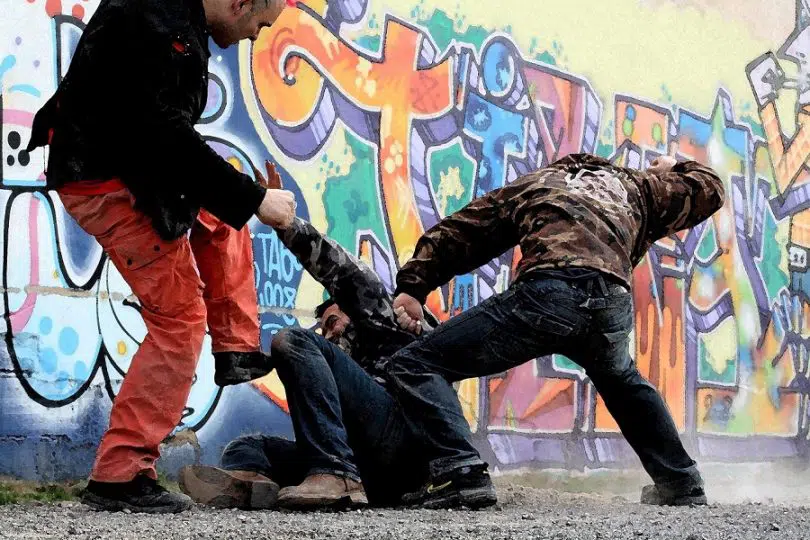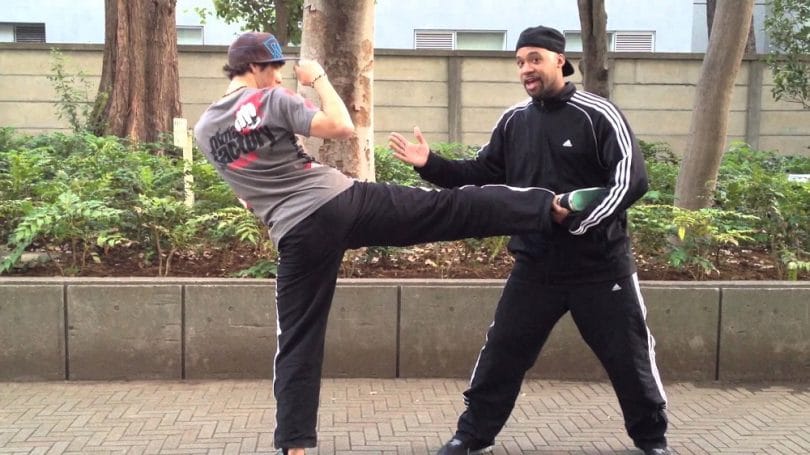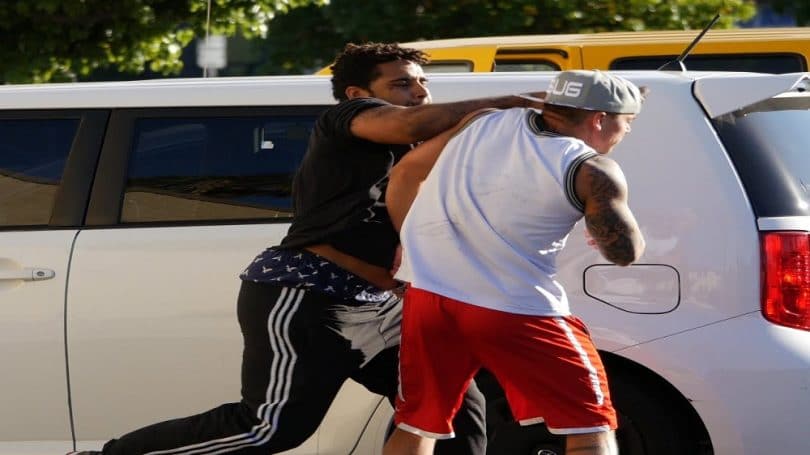Knowing how to street fight can mean the difference between life and death. Protecting yourself is the key and having the skills necessary to do so is tantamount to survival. Many think that the techniques involved in street fighting are nothing but brutal punches and kicks, but there is more discipline to it than you may previously believe. It takes a lot of skill and confidence to engage in such fights and knowing the right tactic to ensure your safety.
The knowledge required to learn how to win a street fight requires constant practice as well as a training of the mind.
Mistake number one: street fighting is not MMA
Mixed Martial Arts (MMA) has become quite popular recently, and there are lots of fans who spend hours watching these harrowing cage matches on television. But spending time as an observer doesn’t give you the muscle memory that you need to engage in street fighting properly. Knowing how to street fight involves one being active and practicing on a daily basis in order to master these techniques.

Even when one has started to learn what is involved in street fighting it’s easy to see that it is unlike MMA or the other forms of traditional martial arts. There are no rules or set forms of stances that are involved in its practice. Rather, it involves examining the situation and knowing the best way to handle it as safely as possible.
Street fighting can involve facing anything from a simple bar brawl to a knife fight in the middle of the street. No two fights are ever the same, and being adaptable to each circumstance is the key. Being spontaneous can certainly help you stay alive, even when the odds seem to be stacked against you.
Mistake number two: don’t put it down
Once you’ve mastered the techniques in learning how to street fight, you don’t stop there. Just like working out, if you stop doing it for long enough, your muscles and your mind will start to get lazy, and that won’t help you in a dire situation. Keeping both your mind and your muscles active will help you be prepared for any situation that’s presented to you.
In order to maximize your potential, it helps to read as many street fighting books as you can find, and watching self-defense DVDs. Each teacher will have a different style that you can add to your repertoire and make it easier for you to expand your knowledge of techniques. The objective is to increase your advantages as much as possible so that the other guy doesn’t get a leg up on you.
Things to know about street fights
When you know what to expect before it happens, you’re better prepared and know just how to react to any given situation. You’re also less likely to be taken by surprise, which is the perfect opportunity for your opponent to take advantage of the situation.

Some of the most basic characteristics of a street fight are:
- streets fights are fast, explosive, and come out of nowhere
- street fighting relies on unpredictability and spontaneity
- street fights are brutal and bloody
- street fights are extremely dangerous and oftentimes lead to death
- most street fights end up on the ground
- opponents will aim for your face and head
- kicking is often used in street fights
- spectators will often get involved, especially if they’re rooting for an involved party
- there are no rules to govern street fights, and lastly,
- compound hand strikes are the most commonly used method of attack
Knowing how to street fight properly will increase your chances of winning, as well as coming away from the fight with as few wounds and bruises as possible. By putting more effort into your training, you can make this a reality.
Differences between conventional and extreme styles
What you may not know is that there is a difference of styles within street fighting itself. However, it’s best to have both kinds in your arsenal in order to properly defend yourself against the various kinds of people you’ll be confronting on the streets.
- Conventional street fighting is what you’ll learn in a majority of self-defense classes. They’re designed to keep you safe and the other party away from you in hopes that they’ll give up eventually.
- Extreme street fighting, on the other hand, is more explosive and comes with more risks. The tactics used are designed to stop someone from inflicting serious bodily injury. They should only be used in life and death situations, where it’s you or the other guy. These techniques can result in broken bones, bleeding, or possibly even death. Care should be used in these kinds of fights, as you’ll be in legal trouble if the situation doesn’t call for the application of lethal force in order to protect your own life.
Want to know about ancient fighting arts? Then, check out our article on the benefits of Tai Chi to learn more.
Knowing how to stand
Before you engage in any street fight, it’s important to have the proper stance that maximizes your potential to defend yourself. The basic of your stance is being as grounded and centered as possible, making it more difficult for your opponent to knock you over. The stance can vary from person to person, as people come in a wide range of sizes, heights, and girth. Finding your center ensures that you have enough stopping power behind your attacks instead of toppling over and making it easier for your opponent to take you out.

The best way to find your center is to imagine a line running vertically that divides your body in half. Along this line are some of the most vital and painful parts of the body that need protecting, such as the groin and the solar plexus. The right stance will help to keep these areas of the body protected and provides balance during your fight. You want half of your weight to rest on both feet, which makes it easy for you to move around in a fight without losing your footing.
Another tip when learning your stance is to keep your hands up at all times. You need to be prepared to defend yourself as well as fight back, and you can’t do that effectively if your hands are at your sides. Even when punching, it’s best to keep the other hand up in case you need to protect yourself from a counterattack.
Your head’s position
In learning how to win a street fight, it’s important that you know how to hold your head. Just like a boxer, the best position is to keep your chin angled down, making your head a smaller target. The eyes, ears and mouth can be hit quite easily, resulting in a lot of pain that can distract you from the situation.
Boxers and other martial arts fighters learn this when they’re just starting out. And in the event that your opponent does punch at your face, their fists will meet with your forehead instead, which is the toughest part of the skull. This is an easy way to break their fingers, rendering their punches useless.
Learning the combat ranges
Knowing the various ranges are the best way to help you learn how to street fight effectively. There are three main ranges that you need to focus on, as they will determine what tactics you should use to stay safe:
- Kicking range: this is the furthest distance from your body, and makes your legs the most effective at reaching your opponent.
- Punching range: this is the range that you’ll be focusing on the most often, and your fists will do most of the talking.
- Grappling range: this is extreme close quarters where wrestling and holds are likely to be involved. Head butts, biting and clawing are generally effective in this range, as well as choke holds to knock your opponent out.
Factors to look for
When you’re involved in a street fight, there are important factors to look out for that will help you gain and keep the upper hand.
- The first is the distance of the combat. Knowing how far you are from your opponent will tell you what fighting range tactics should be used.
- Secondly, the type of confrontation you are facing. Are you defending yourself from a surprise attack, or do you need to only subdue the other person. The level of intensity of the fight will help you to choose the right tactics necessary to neutralize your opponent.
- Thirdly is to see whether you’re facing an armed opponent or not. The kind of weapon he’s holding also makes a difference, as you would defend yourself differently from a knife than you would a bat.
Blocking, parrying, and evading
Before learning the offensive skills, knowing how to defend yourself is crucial! There is even a saying that goes like that: “the best offense is a good defense”. Staying mobile and maintaining your stance is essential, as well knowing how to block incoming attacks. Your arms are likely to be your best source for blocking, but improvising with the items in the environment around you can help, especially if your assailant is armed.
One of the most important elements of defending yourself is to refrain from blinking during the fight when punches and kicks are coming towards you. In that split second, you’re left defenseless, and you can easily lose. It takes time, courage and practice to learn to control your blinking during a fight, but it will certainly save your life.

Parrying is a way to redirect your assailant’s attack. This unexpected tactic can throw him off-balance and make it easier for you to eliminate the threat. This method is extremely useful if you’re starting to get tired during a fight, or your arms are too sore to continue blocking.
Evasion is stepping out of the way of the attack entirely. This can also serve the purpose of forcing him to lose his balance and give you the upper hand without much effort on your part.
How to be offensive
This isn’t what it sounds like. In addition to defending yourself, delivering strikes that render your opponent harmless is important to staying alive and unhurt. Knowing where the most vulnerable parts of the body are and how to make use of them is the key to ending a fight before it becomes too serious.
One mistake many people make is to judge the level of their opponent’s skills by how they carry themselves. Underestimating your opponent is the best way to lose. Treat everyone you face as if they’re a master in all forms of street combat. This way, you won’t be surprised when he does something unexpected and gains the upper hand.
Another mistake most people do is to succumb to the stress of the situation. It’s a given that a street fight, in and of itself, is quite stressful, but it’s important to remain as calm as possible so that you can assess each situation and respond accordingly. Don’t tense up and hold your breath, as this leads to stiff muscles that don’t respond well and can actually make you dizzy. Practicing the proper breathing technique will help to relax your muscles and make your movements more fluid, whether you’re throwing a punch or defending yourself.
A third mistake is telegraphing one’s intentions. There are small movements of body language that give yourself away in a fight and make it easier for your attacker to know what you’re doing. This can involve anything from cocking your arm back for a punch, or taking a sudden inhale in preparation for an attack. Training will teach you how to minimize these “tells” so that your actions will always be unpredictable.
When it comes to actually attacking, it’s important to note that you should only inflict enough damage that renders incapable of continuing his attack. This means targeting certain areas, such as the knees, ankles, groin, and other soft parts of the body that are very painful when hit. The body can be divided into a variety of zones that differentiate the best body parts to strike.
- Target Zone 1: areas of the head and face; includes eyes, nose, chin, temples, and the back of the neck. Targeting these areas affects your opponent’s senses.
- Target Zone 2: areas of the upper body; includes neck, solar plexus, ribs, and groin. Targeting these areas affects your opponent’s breathing.
- Target Zone 3: areas of the lower body; includes the knees, shins, ankles, and thighs. Targeting these areas affect your opponent’s mobility.
When you’re facing a particularly dangerous opponent, it’s best to strike first, fast, and hard. Don’t give him the opportunity to gain the upper hand, or you won’t make it out of the situation unscathed. A first offensive strike that’s well-delivered can take him out in a second and make it much easier for you to escape.
Grappling situations
Throwing punches and kicks are all well and good, but when you’re on the ground, they won’t be able to do much for you. Learning the proper holds and grapples can subdue the situation quite quickly and effectively. Targeting the neck to knock your opponent out or getting his arms locked behind his back also take a lot less effort than defending yourself from attacks. All it needs is a few pounds of pressure to render your assailant immobile or unconscious.
For hand to hand combat tips and tricks, check out our article on this topic.
A quick rundown
In the event that you face a sudden street fight, knowing what to do in a pinch will help to keep you safe. These key tips will teach you how to street fight and avoid being sent to the emergency room.
- Pay attention. When someone is threatening you, be aware of your environment and what you have at your disposal. Those few seconds could mean the difference between life and death.
- Attempt to diffuse the situation. Before you resort to using your fists, start by using your words. Assess the cause for the animosity and see if some common ground can be arrived at. Letting your ego get in the way of things is the best way to stew up trouble and make the situation worse. At the same time, don’t reveal to him that you’re afraid, or he may take advantage of the situation and start a fight anyway.
- Try to walk away. This may seem counterintuitive at first, but trying to escape may be your best first choice of tactics. If he can’t be reasoned with, turn around and walk away. If he pursues you, then the street fight is about to start.
- First, assume the fighting stance. Get yourself grounded with your feet at least shoulder-width apart so that you have balance. Keep your hands up to protect yourself and keep your mouth closed. Not only does this spare you from a broken jaw if you’re punched, but it also minimizes the chances of you biting your tongue.
- Be prepared to defend yourself. There are no rules here, so be prepared to fight dirty. Use whatever you have at your disposal to ensure your safety, including the objects around you. Some of the best areas to target to end the fight quickly are a knee to the groin, kicking the knees or stomach, or head-butting someone in the face. If all else fails or you miss, don’t be afraid to start throwing a few punches.
- Take punches effectively. Dodging them is always best, but you may not have the steam to maintain it. If you’re taking a punch to the head, step towards it or absorb it with your forehead. To the body, tighten your stomach muscles to absorb the blow. Shifting your body with the punch can result in it hitting less vital and painful areas.
- Make noise. In fact, make as much as possible. It’s an intimidation factor that will psych out your opponent the louder you get. The noise will also attract attention, hopefully that of someone who can call the authorities.
- Escape at your first chance. In the event that you have an opportunity to escape, take it. Continuing to wail on your assailant long after he’s incapacitated can land you in a world of legal trouble.
Quick tips
If you’re interested in learning a few tips to street fighting on your own before you decide to enroll in a class, there are a few YouTube videos that can help you understand what’s really at stake when you’ve found yourself in these situations. Take these videos with a grain of salt, as nothing is more effective than learning these techniques face to face from a real teacher.
fightTIPS is a great channel that teaches people how to street fight and acquire self-defense techniques.
Learning the frequent mistakes that people make during a street fight will help you improve upon your street fighting techniques:
Another important video from fightTIPS is learning how to fight dirty. It can be difficult for people to want to take advantage of the fight unfairly, but if you don’t, the other guy will:
FightSmartTrav teaches people how to dodge punches through simple head movement.
and check out this video too:
He also provides lessons on how to stay calm during a fight so that you can continue to defend yourself and attack effectively
If you’re looking for fast and effective ways to end a street fight, Nick Drossos provides lessons on which hits will take out your opponent quickly.
When it comes to street fighting, playing it smart is the best way for you to stay alive. It’s easy to succumb to fear and let the situation dictate how we respond, but by gaining confidence in these methods and training our bodies, we can cease control.
Learning to take the punches and defend yourself will make it easier for you to develop a sound strategy to eliminate the threat and minimize your chances of getting injured. These dangerous situations can come at any time and from anyone, so having these tactics in mind and training will make you an effective fighter, no matter the situation you find yourself in.
For more information on how to find your style in martial arts for street fighting, read our article on this topic.






This is a very interesting read. I do agree that there are no rules when it comes to street fighting and you should always keep your hands up, either for offense or defense. You should also learn to improvise and be resourceful in using your environment for both offensive attacks or defensive maneuvers. It is this awareness that will help you become a better street fighter.
Getting in a street fight is one of the nastiest situations in surviving. Everything is permitted. What’s even nastier is fighting with a girl, it can happen to anyone, and it is very dangerous. Everyone will take the girl’s side, even if she started the fight, and you stand a little chance to win, I hope I don’t ever get in a street fight with a girl.
Avoiding a street fight is often the best choice. There is also no cowardice in running away unless someone else’s safety depends on you. It is generally a nasty situation and should be engaged in only if necessary.
Nonetheless, always be prepared.